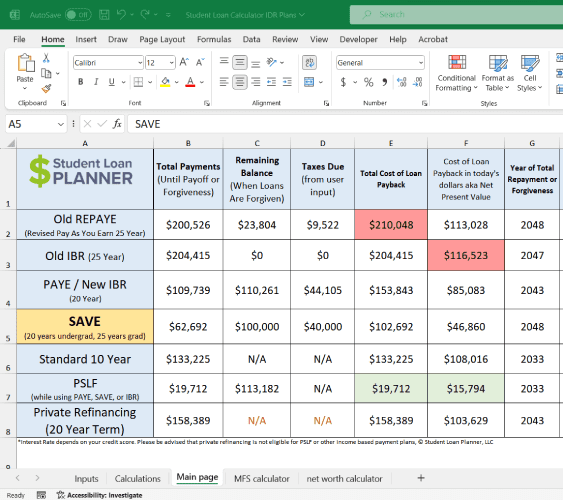Your annual total tax liability is calculated using your adjusted gross income (AGI) as a base. However, it also functions as a major component in determining your federal student loan payment amount under an income-driven repayment (IDR) plan.
There are numerous ways to successfully lower your AGI, which will therefore lower your income tax liability and student loan payment. Here’s how.
Understanding AGI
One significant financial indicator that affects your options for repaying student loans is your Adjusted Gross Income (AGI). It is your total income less a few “above-the-line” deductions—expenses you can write off before figuring out your taxable income.
To find out if you qualify for income-driven repayment (IDR) plans and other benefits related to student loans, you must know your adjusted gross income (AGI). AGI is frequently used by these plans to calculate your monthly payment amount and possible loan forgiveness.
Calculating Your AGI
Calculating your AGI involves two main steps:
-
Determine your total income: This includes your wages, salaries, tips, self-employment income, interest, dividends, capital gains, and other taxable income sources.
-
Subtract eligible deductions: These deductions, also known as “above-the-line” deductions can significantly reduce your AGI. Common examples include:
- Student loan interest: You can deduct up to $2,500 in interest paid on qualified student loans each year.
- IRA contributions: Contributions to traditional or Roth IRAs can be deducted from your AGI, subject to income limitations.
- Health Savings Account (HSA) contributions: If you have an HSA, your contributions can be deducted from your AGI.
- Alimony payments: If you made alimony payments as part of a divorce agreement before December 31, 2018, you can deduct them from your AGI.
- Educator expenses: Educators can deduct certain expenses related to books, supplies, and other professional development costs.
- Moving expenses for members of the Armed Forces: Active-duty military personnel can deduct certain moving expenses.
AGI and Student Loans
Your AGI plays a critical role in determining your eligibility for various student loan programs:
- Income-driven repayment (IDR) plans: These plans base your monthly payments on a percentage of your discretionary income, which is calculated using your AGI. The lower your AGI, the lower your monthly payments will be.
- Public Service Loan Forgiveness (PSLF): To qualify for PSLF, you must work full-time for a qualifying employer and make 120 qualifying payments under an IDR plan. Your AGI will determine which IDR plan is most beneficial for you to reach forgiveness faster.
- Income-based repayment (IBR): This plan caps your monthly payments at 10% of your discretionary income, which is calculated using your AGI.
- Pay As You Earn (PAYE): This plan caps your monthly payments at 10% of your discretionary income, but it also considers your spouse’s income if you file jointly.
- Revised Pay As You Earn (REPAYE): This plan caps your monthly payments at 10% of your discretionary income and offers the lowest possible monthly payment among all IDR plans.
Additional Resources
To learn more about how your AGI is calculated and how it affects student loans, check out these resources:
- The College Investor: This website provides a comprehensive guide on calculating your AGI and its implications for student loans.
- StudentAid.gov: The official website of the U.S. Department of Education offers detailed information on income-driven repayment plans and other student loan programs.
- IRS Publication 17: This IRS publication provides detailed information on various tax deductions, including those related to student loans and other education expenses.
By understanding your AGI and its role in student loan repayment you can make informed decisions about managing your student loan debt and maximizing your financial aid options.
Increase your pre-tax contributions to your retirement plan
Making contributions to a pre-tax retirement plan can help you prepare for retirement by lowering your adjusted gross income (AGI). Contributions to a traditional Individual Retirement Account (IRA), 403(b), 457, government pension fund, or 401(k) are included in this.
Note: It doesn’t include Roth IRA contributions since that type of retirement plan involves after-tax dollars.
If your employer offers a retirement plan, you can dramatically reduce your annual gross income (AGI) by making the maximum annual pre-tax contributions.
For example, the 2023 IRS maximum limit for a 401(k), 403(b) and most 457 plans is $22,500. Be aware that the annual maximum for both a 403(b) and a 457 account, if you work for the government, is $22,500.
There’s also the option to max out a traditional IRA at $6,500 per year regardless of whether your employer offers a retirement plan. However, your deduction might be reduced, phased out or eliminated if you or your spouse are covered by a retirement plan at work, depending on filing status and income. In this case, there are modified AGI limits to consider.
Keep in mind that your spouse can contribute to their own IRA or employer-sponsored retirement plan.
Get Started With Our New IDR Calculator

Adjusted Gross Income, Explained in Four Minutes | WSJ
FAQ
How do I figure out my adjusted gross income?
Is student loan based on AGI or taxable income?
What is the adjusted gross income for student aid?
What is modified adjusted gross income for student loans?
